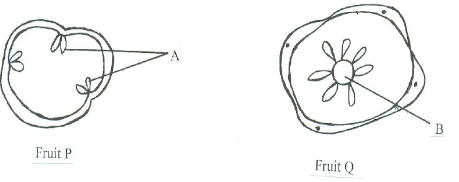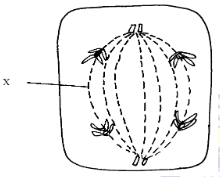INSTRUCTIONS TO CANDIDATES
- Answer ALL questions.
- What is the function of the following in a microscope?
- Mirror (1mk)
- Diaphragm (1mk)
- Use the chart below to answer the questions that follow

Name: -- The blood cell represented by A (1mk)
- Metal ion represented by B (1mk)
- End product represented by C (1mk)
- Below is a nucleotide strand
A – A – G – T – C- Is it a DNA or RNA strand? Give a reason (2mks)
- Give the bases which would appear on the complimentary nucleotide strand (1mk)
- Below is a diagram of a white blood cell.
- Describe how the bacteria got into the cell (2mks)
- What happens to the bacteria once in the cell? (1mk)
- Give three reasons why mitosis is important in living organisms (3mks)
- Give the characteristics which adapt flowers for wind pollination (4mks)
- Name one waste product that is :
- Almost absent in the renal vein but is present in the renal artery (1mk)
- Transported in the blood but not removed by the kidneys (1mk)
- State two functions of the large intestines in human beings (2mks)
- Identify the mode of feeding of the animal whose dental formula is given below.
- Mode of feeding (1mk)
- Give a reason for your answer in (a) above. (2mks)
- Name the agent that causes:-
- Cholera (1mk)
- Typhoid fever (1mk)
- Amoebic dysentery (1mk)
- Outline three roles of active transport in the human body (3mks)
- State three ways in which nitrogen in the air is made available for plant use (3mks)
- In an attempt to estimate the number of weaver birds in a small woodland 435 were captured , marked and released. Three days later , 620 were captured 75 of which were marked.
- What is the name of the sampling method described above. (1mk)
- Calculate the approximate size of the weaver bird population in the woodland. (2mks)
- Give one disadvantage of this method. (1mk)
-
- Name the hard body covering found in organisms in Arthropoda (1mk)
- State three uses of the structure mentioned in (a) above (3mks)
- Study the diagram below and use it to answer the questions that follow
- Mention the equivalent of the following in the mammalian breathing mechanisms:-
- Bell jar (1mk)
- Balloons (1mk)
- Does the diagram represent inhalation or exhalation? Give one reason for your answer (2mks)
- Mention the equivalent of the following in the mammalian breathing mechanisms:-
- Explain two advantages of endoderms like man over ectoderms like lizards (2mks)
-
- Name the property that enables lipids to be stored in tissues of organisms (1mk)
- State two reasons why a camel stores large fat reserves in its body (2mks)
- Below are cross sections of two fruits. Study them and answer the questions that follow
- Name the parts labelled
- A……………………………………………………………………. (1mk)
- B …………………………………………………………………… (1mk)
- Name the type of placentation in fruit (2mks)
- P……………………………………………………………………
- Q……………………………………………………………………
- Name the parts labelled
- Which region of mammalian digestive tract does digestion of fats begin? (1mk)
- A Rhesus positive man, heterozygous for the trait is married to a rhesus negative woman. Carry out a genetic cross to show the offsprings of this couple.
- The diagram below represents a stage during cell division.
- Identify the stage of cell division. (1mk)
- Give two reasons for your answer (a)i) above (2mks)
- Name the structure labelled M. (1mk)
- State two organelles absent in members of kingdom monera but present in members of kingdom protoctista (2mks)
- Name the substance produced during anaerobic respiration in animals and state why it should be got rid off immediately (2mks)
- What makes it difficult for seeds to germinate at the following temperatures:
- 0°c
- 47°c
- State two major functions of adipose tissue (fat) in mammals (2mks)
- Below is an equation for respiration
C57H104O6 + 80O257CO2 + 52H2O + Energy- Name the type of respiration taking place (1mk)
- Calculate the respiratory quotient (RQ) (2mks)
- Identify the type of food being metabolized. (1mk)
- State one significance of interphase in cell division (1mk)
-
- What is the role of light in the light stage of photosynthesis? (1mk)
- What are the products of the light stage of photosynthesis? (2mks)
MARKING SCHEME
-
- Mirror – reflects light through the condenser to the object (1mk)
- Diaphragm – regulates the amount of light passing through the condenser to illuminate the specimen; (1mk)
-
- Platelets; (1mk)
- Calcium ions; (1mk)
- Fibrin; (1mk)
-
- DNA; base thymine is present (Thymine is absent in RNA strand); (2mks)
- T – T – C – A – G; (1mk)
-
- An invagination develops at the area of contact with the bacteria/the cell membrane fold and cytoplasm flow around the bacteria forming a food vacuole/phygocytic vesicle; a process called phagocytosis (2mks)
- Lysosomes secrete enzymes into the food vacuole/phagocytic vessicle; digestion occurs; soluble food diffuses into the cell; undigested materials are expelled when the vacuole moves to the edge and fuses with plasma membrane (2mks)
- Growth; repair of tissues, maintenance of genetic material/retain chromosome number, asexual reproduction; (3mks)
- Large quantities of pollen grains; smooth pollen grains; loosely hanging anther; small light pollen grains; large fatherly stigma; long filament (any 4; 4mks)
-
- Urea;
- Carbon (iv) oxide;
-
- Absorption of water mineral salts e.g. iron, calcium; and absorption of vitamins;
- Secretion of mucus that holds faecal matter and lubricates the intestinal wall for smooth passage of faeces; (2mks)
-
- Herbivorous rej. Herbivore (1mk)
- Absence of incisors and canines on the upper jaw. (2mks)
-
- Vibrio cholerae;
- Salmonella typhi;
- Entamoeba hystolytica; (3mks)
-
- Reabsortion of glucose and some mineral salts by the kidney tubules;
- Absorption of digested food, mineral salts and vitamins from the alimentary canal into the blood stream ;
- Excretion of waste products from cells; reabsorption of useful materials into the bloodstream from tissue fluid; (any 3; 3mks)
-
- By rhizobium bacteria into root nodules of leguminous plants;
- By action of lightning;
- By azotobactor, chlostridium;
- By haber process/industrial fixation
(Any 3; 3mks)
-
- Capture recapture method. (1mk)
- P = Fm x sc
MR
= 435 × 620
75
=3596 weaverbirds. (2mks) -
- The released animals may not mix freely .
- Some organism may move in and out of the study area. (1mk)\
-
- Exoskeleton/cuticle; (1mk)
- Provide a large surface area for muscle attachment; protect internal organs from injury; prevent entry of harmful micro-organisms (any 3; 3mks)
-
-
- Bell jar – ribcage/thorax; (1mk)
- Balloons – lungs; (1mk)
- Inhalation; because balloons are filled with air; the rubber sheet representing diaphragm is flattened; (2mks)
-
-
- Endoderms are active throughout while ectoderms are active when the environmental temperatures are low;
- Endoderms are widely distributed in different areas while ectoderms are found in areas with relatively high temperatures (2mks)
-
- They are inert;
- The fats are a source of metabolic water; they are a source of energy;
-
-
- A – Seeds; (reject seed) (1mk)
- B – Placenta; (1mk)
-
- P – Parietal; (1mk)
- Q – Free central; (1mk)
-
- Duodenum;
-
- Mitochondrion; nuclear membrane; (2mks)
- Lactic acid; toxic/poisonous to the body cells;
-
- At 0°c the enzymes responsible for germination are inactivated;
- At 47°c the enzymes are denatured;
-
- Insulate the body;
- Oxidized to release energy and water when carbohydrates are exhausted; (2mks)
-
- Aerobic respiration (1mk)
- RQ = CO2 produced (1mk)
O2 consumed
= 57 (2mks)
80
= 0.7 - Fats/lipids (1mk)
- Replication of organelles; duplication of DNA; production of energy (ATP) for entire cell division (1mk)
-
- To break down water into its components /splits water molecules into oxygen and hydrogen ions;
- Hydrogen; oxygen; chemical energy/ATP;
Join our whatsapp group for latest updates
Tap Here to Download for 50/-
Get on WhatsApp for 50/-
Download Biology Paper 1 Questions and Answers - Sunrise Pre Mock Exams 2023.
Tap Here to Download for 50/-
Get on WhatsApp for 50/-
Why download?
- ✔ To read offline at any time.
- ✔ To Print at your convenience
- ✔ Share Easily with Friends / Students






